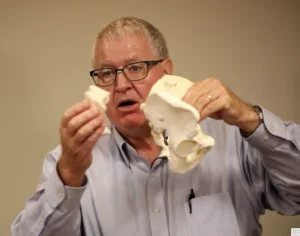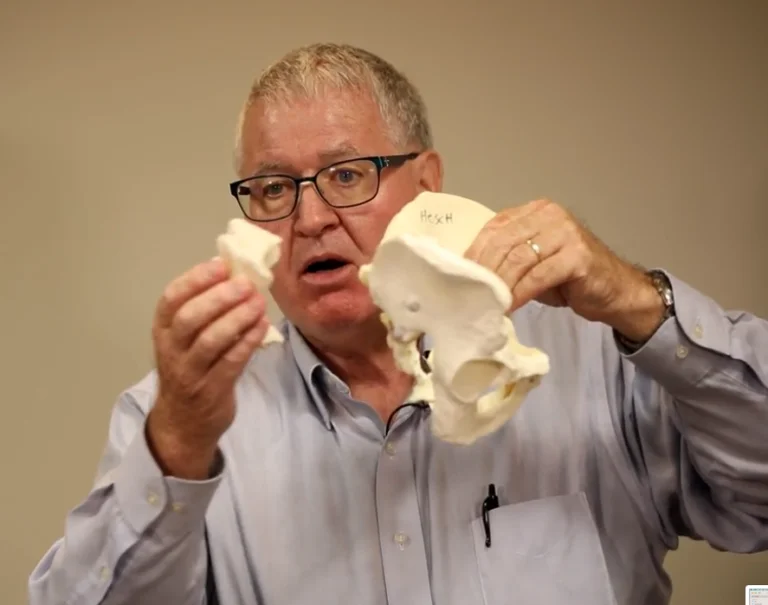There are a lot of under-informed and just plain false beliefs about the sacroiliac joint pain. Dr. Jerry Hesch busts some common sacroiliac joint myths that may change everything you think about this supposed troublemaker.

In this interview with Dr. Hesch, you’ll discover:
- Myths about hypermobility and sacroiliac joint pain
- Whether you can visually assess sacroiliac joint misalignment
- Effective methods to assess and treat sacroiliac and pelvic instability and pain
If you’re interested in busting up some sacroiliac joint myths, learning more about the Hesch Method, and even getting certified as a Sacroiliac joint specialist, read our Sacroiliac Joint Pain Certification Review: Get the Best Results Quickly!
What are one or two of the biggest sacroiliac joint myths and sacroiliac pain?
Sacroiliac Joint Myth #1: Hypermobility is the root of sacroiliac joint pain.
One of the biggest sacroiliac joint myths is that people, including people with diagnosed hypermobility syndrome, believe that in response to an injury, they have developed chronic, difficult-to-treat hypermobility or instability. The way the body responds to passive forces, such as from an injury, be it a fall or a lifting injury, is that the joint can move to end range and then become stuck. This is a very important, under-appreciated concept and understanding it can save a lot of frustration, save money, and expedite effective treatment.
So, this is a problem of hypomobility, not hypermobility.
Well, that is 1/2 truth.
Let’s inspect this sacroiliac joint myth.
In one direction, the motion has been lost or greatly reduced and this can be evaluated with the passive Spring Tests that I have developed. This type of injury can alter muscle, tendon, and ligament tension and on that side of movement reduction, those structures will become tightened. In the opposite direction, structures have become relaxed, and therefore, in that direction, there will be a treatable hypermobility. Injections designed to develop scar tissue into those ligaments will fail because this laxity is due to a malposition, as opposed to damage to ligaments.
The correct treatment is to restore the normal neutral position of the joint and forces will then become balanced on both sides of the joint. Many people recover beautifully when a thorough hands-on assessment is performed. The direction of hypermobility is corrected. Then pain is reduced, muscle inhibition is reduced, and normal tone in the ligaments, tendons, and muscles is restored.
Sacroiliac Joint Myth #2: Pain relief following an injection into the SI joint indicates SI dysfunction.
The second sacroiliac joint myth is that injection into the joint space of the sacroiliac joint is very accurate and is diagnostic of the joint as being the source of the pain. The injection is oftentimes utilized to justify sacroiliac fusion.
I have spoken to several medical doctors who are anesthesiologist and chronic pain injection specialists. They agree with me that the injection into the SI joint is much too general because that joint has a very broad range of nerve input from almost the entire lumbar spine and the upper 3 sacral nerves.
An injection of an anesthetic agent can therefore reduce pain, even if it’s coming from the hip joint, which has a similar innervation as the sacroiliac, and even if the pain comes from the lumbar spine. There are sensory nerves from the lumbar spine that cover the skin and ligaments overlying the sacroiliac.
So, yes, it can hurt over the SIJ, but the source can be lumbar nerves.
How would I solve this dilemma if I were the person getting the injections?
I would also get injections into the lumbar spine to see if there is referred pain to the sacroiliac joint, and I would also see a hip specialist to determine if my hip was the source of the pain.
Sacroiliac Joint Myth #3: The Most Common SIJ Tests are Reliable
In the video below, I address another big sacroiliac joint myth: that the common sacroiliac joint tests are reliable. I’ve studied all the relevant scientific literature, they just don’t support these tests. This is a major sacroiliac joint myth, and it’s really time to move on past it.
That’s why the Hesch Method has its own tests, which have greater reliability and consistency in findings between specialists trained in the method.
Can you tell us what sets the Hesch Method apart from other approaches when it comes to addressing pain in the pelvic region?
The Hesch Method evaluates micromotion and restores micromotion. Micromotion in the SIJ is a very important fundamental of the joint because the SIJ functions primarily as a shock-absorber and it translates and modifies forces that go through it from the spine and trunk above such as when lifting something with the arms and bending the spine, and through the legs such as when walking.
When micromotion is reduced (hypomobility on one side and hypermobility on the opposite side) the structures close by have to take up more of the load and then can have altered tension, altered blood flow, induce muscle inhibition, etc.
The Hesch Method also utilizes palpation of the SIJ ligaments to determine if they are lax or if they are hypotonic. I have treated many patients with ligaments on one side of the SIJ that were too tight from malposition, yet they spent $5-15,000 to get injections.
This is unfortunate, but social media contributes to sacroiliac joint myths of how the joint functions. This contributes to why so many patients have had limited results to injection, but professionals still promote prolotherapy, prolozone, stem cell injection, etc.
You mention that you are personally aware of pelvic pain due to complications following a motorcycle accident. How has your own journey with pain and recovery shaped the Hesch Method’s approach to pain in the hip complex?
I began my journey doing a lot of reading of the medical literature which I still do regularly. When I learned that the SIJ functions as a shock absorber, I developed many tests similar to the tests used to evaluate the shock absorber in your vehicle and similar to orthopedic joint and ligament tests performed manually by old-school orthopedic surgeons. However, those tests have become a lost art, and some approaches such as MET/Muscle Energy do not utilize spring tests.
I came to discover that I had a unique, rare presentation in my pelvic joints, and I developed a very effective self-treatment which I performed on myself for 5 minutes. On occasion, I may have to repeat the treatment, but I quickly recover. This low-force and prolonged-force application is much more effective than popping or adjusting joints.
Most of my treatments take 119 seconds longer than an “adjustment” and require a greater commitment than adjusting or using other methods such as MET/Muscle Energy. Using my method (adjustments happen in approximately 1/3 of a second) and they give lasting relief such that I appropriately refer to them as “Corrections”.
Your Sacroiliac Specialist course is noteworthy for your knowledge of the relevant scientific literature. Have there been any recent findings that you think are worth mentioning?
Yes, I am constantly learning and developing new methods of evaluation and treatment. Do you know that the typical model of evaluation and treatment was developed in 1958? It has remained static, and the sacroiliac joint myths perpetuate.
I started to develop my approach in 1981, and I continue to tend to it just like a good gardener tends his/her garden. I have discovered a few very rare patterns in the pelvis in the past 12 months and I have made discoveries in other parts of the body. When I treat the SIJ, I also evaluate and treat the entire body because patterns do develop “stem to stern”. Sadly, most clinicians seem to focus only on the sacroiliac area for a diagnosis of SIJD.
If there’s one patient story that you think best attests to the techniques you share in your Sacroiliac Specialist Certification, what would it be?
I was doing home health care. An elderly woman had pancreatic cancer and had suffered a fall developing SIJ Dysfunction. She was bed-bound and wanted to come to sit at the dining room table for meals with her family but even using a walker was too painful.
I was worried that the cancer may have invaded her SIJ.
By performing a few basic Hesch Spring Tests, I determined that the joint was stable and had blocked motion in the posterior direction of the ilium and increased motion in the opposite anterior direction of spring testing the ilium. The pattern she had is named Anterior Ilium and it is not based on how the pelvis looks, nor how the pelvis moves when you bend forward or lift your leg (traditional tests), but rather, how it responds to spring tests.
It took me 2 minutes to treat, and normal mobility and stability were restored in both directions. I had a follow-up visit a week later and she was no longer in pain and all week she was able to walk to eat with her family.
This method is easy to use, and many injuries respond very quickly to intelligent evaluation and gentle treatment. Patients are then taught simple self-maintenance.
Jordan’s Story: A ten-year-old boy could not walk due to pain. A therapist thought he had an “Upslip of the Ilium” because his ilium was higher due to muscle protective guarding. He had a Downslip Ilium which was made worse with a vigorous leg pull.
“One should never treat based on how the pelvis appears visually. The case illustrates the importance of spring testing and shows how important it is to evaluate the tone of the supporting ligaments. He is a grown adult and continues to do very well.” Dr. Jerry Hesch
Thank you for this opportunity to share some thoughts on some common sacroiliac joint myths!
About Dr. Jerry Hesch
Dr. Jerry Hesch is a physiotherapist who also has a Masters degree in Human Sciences. He has maintained an active clinical practice for over 40 years, where he studied, refined, and created a full-body approach to manual therapy, the Hesch Method. Dr. Hesch is an active researcher with a number of academic publications. He is the founder of the Hesch Institute, through which he has trained over 10,000 clinicians in the Hesch Method. He offers certifications in the sacroiliac joint, cervical spine, and the full body.
Feel free to check out our Sacroiliac Joint Pain Certification Review: Get the Best Results Quickly.

